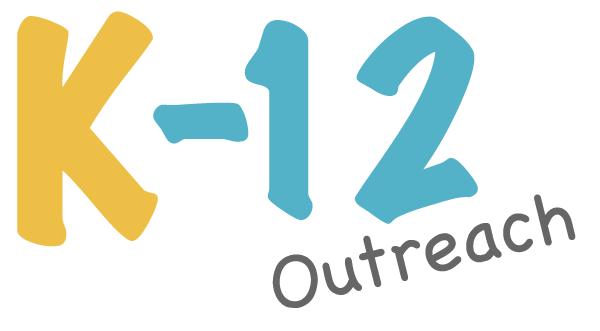BY David Greenwald , Illustrations by Students from the UCLA Lab School and UCLA Community School
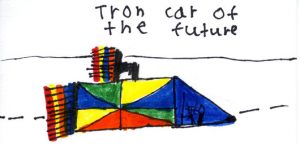
What will the workplace look like in 2030? We asked Bruin kids and faculty to peer ahead and tell us what they foresee. They agreed on some things, disagreed on others. The professors think technology will make the working world fluid and movable. The kids are excited by the prospects of flying motorcycles, holograms and rocket-propelled basketball shoes. Either way, the future workplace figures to look nothing like it does todayThe Lab School’s Annabel Zimmer, age 8, is going to be a singer who warms up her voice with the aid of a hologram trainer in 2030. She will drive to work in “a red Tesla.” For those who don’t like high-end electric sports cars, there will be solar-powered moving sidewalks.When Jonathan Greenblatt, who lectures on social entrepreneurship and global marketing in the UCLA Anderson School of Management, is asked what he thinks the workplace of the future will be like, he doesn’t look first to books or to management scholarship for insights. Instead, he turns to Ilan, his 7-year-old son, who envisions a future where workers will continue to go to offices, but “sometimes in meetings people will use holograms to talk to each other.”
Today’s children are both witnesses to and willing participants in the tectonic shifts that technology has brought to every aspect of society. And while kids may not yet fully grasp that abstract concept we call “the workplace,” they know that by the time it’s their turn to bring home the bacon, the picture will be far, far different than it is today.
Like Greenblatt, we also turned to children to lead us in an exploration of the workplace of 20 or 25 years from now. Our pundits: students at the UCLA Lab School and UCLA Community School, ranging in age from 5 to 14. And for a reality check, we turned to professors — the world-class faculty at UCLA Anderson — to see how closely the kids’ predictions hewed to what the experts believe might actually happen. Not surprisingly, the youngsters didn’t offer much detail about their day-to-day work lives; they do, however, foresee no shortage of fantastic and delightfully imaginative, if unlikely, scenarios. The scholars, not surprisingly, tended to concentrate more on the big picture than on whether people will commute to work in hover cars.
But one thing both groups agreed on: It would be really, really cool if there were robots.
Anytime, Anyplace, Anywhere
Jerry Nickelsburg, the oft-quoted senior economist for the iconic UCLA Anderson Forecast, notes that: “If we had been asked 25 years ago to predict what the world of work might look like today, not many of us would have gotten it right. We had no concept of the Internet, that’s for sure. We may have been talking more about robots and colonies on the moon.”
Still, you don’t have to be an avid reader of Fortune or The Wall Street Journal to know that technology has fundamentally changed how work gets done today. The Web, e-mail, smartphones and social networking have combined to make the world significantly smaller by expanding our ability to not only communicate with the coworker in the next office, but also to effortlessly reach across cities, states and continents to customers and collaborators in faraway places.
In many jobs, technology has made it possible to work from virtually anywhere. What we recognize today as the office is shifting “from a physical place that we visit five days a week to a conscious state, an ever present aspect of our day, and our night,” says Greenblatt. Just as we are able now with DVRs to choose our own time for watching television programs, “people will increasingly time-shift their professional commitments, blurring the lines dividing work and leisure,” he predicts.
This part of the future is already taking shape. Increasingly, firms (and universities, for that matter) are outfitting their employees with digital devices like iPads and smartphones, making it possible for workers to remain tethered to their jobs no matter where they might be. According to a recent forecast by the consulting firm Deloitte, U.S. companies will purchase more than 10 million tablet computers (out of a total 50 million sold) for their employees in 2011. When tablets are coupled with the growth of smartphone sales, business purchases this year will, for the first time, dominate the total computing device market, Deloitte says.
Indeed, opportunities may abound for those flexible enough to meet the new changes. There will be growth in what is being called the “boundaryless career,” says Barbara Lawrence, UCLA Anderson professor of human resources and organizational behavior. “The basic premise is that more and more people will create their own careers outside of traditional organizational boundaries, taking their skill sets across organizations, occupations and industries,” she says.
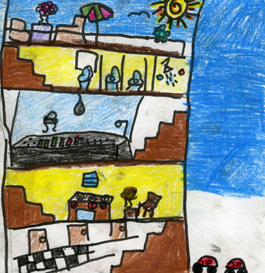
That mobility will provide workers with more choices about the skills they wish to develop, and when they want to develop and employ them. “People won’t get stuck in organizations in positions where they feel they have no future,” Lawrence believes. “Moreover, they become independent of an organization’s promotion, hiring and layoff decisions. The ideal boundaryless career allows an individual to decide for him or herself what ‘career’ means.”
It’s not going to be a digitally powered Utopia, of course. Greenblatt worries that applications such as social networks will further enmesh people in a loop of constant engagement, “collapsing the walls that once neatly separated our cubicles from our kitchens, our professional and personal lives. Everything will be in the open, everyone will be ‘on’ and everywhere will be your ‘office.'”
And what about the tools with which today’s kids will do tomorrow’s work?
“Is it going to be robots? Is it going to be computers that run on biological systems? I have no idea,” Nickelsburg concludes. “That’s what makes the future exciting, and I hope I live long enough to see it.”
Fly Me to the Moon, Professor Battle Robot
Our youngest prognosticators also expect a great deal of personal and physical freedom in their professional lives. They don’t always agree with the academics on the other details of their future work lives, however. Being born into a world in which technology-driven change is a constant, they’re not much worried about any downside, either.
Well, maybe a little.
Extending today’s trends, “the world will be more technology-savvy,” but that will leave little room for human employment, worries Alesa Menor, 11. “Most of the jobs will be done by robots and machines. For example, house chores, repair and maintenance of automobiles, teaching in schools and universities, and services in banks, groceries, beauty salons and barbershops will be done by robots and machines. The bottom line is that there will be more jobs, but, unfortunately, very few human jobs.”
While this might lead to even more extensive unemployment than we are experiencing currently, Alesa does not plan to be among the jobless. She’s already figured out that nursing is the career that offers the most opportunity. There will always be a need for human nurses, she figures, and the advances in technology will allow more time for direct patient care “and less time for paperwork.”
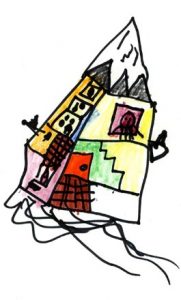 Overall, though, it is oddly comforting to see that today’s children imagine a working future very similar to the one we daydreamed about when we were their age. It is largely a Jetsons world of flying cars, teleporters and jetpacks that transport people from home to office — yes, they think there still will be offices — and once there, amazing gadgets to ease working life.
Overall, though, it is oddly comforting to see that today’s children imagine a working future very similar to the one we daydreamed about when we were their age. It is largely a Jetsons world of flying cars, teleporters and jetpacks that transport people from home to office — yes, they think there still will be offices — and once there, amazing gadgets to ease working life.Which, happily, brings us to robots.
Make no mistake, robots will be big figures in the working world of tomorrow, at least in its ivory tower manifestations. We’re talking really big — “about 50 feet tall,” predicts Atticus Chang, 9.
Atticus foresees a future academy that includes “a professor of battle robots.” He has a giddy accomplice in Maxam Lemmon, 9, who imagines a “Robot Police Society.” It will be his job to control “the Legendary Godzilla Character Destroyah,” a five-story Rambobot equipped with “maximum stealth, missile launchers, flamethrowers, Taser guns, bazookas and machine guns.”
Killer robots in the workplace are rad, but what about genteel ones, like helpful Rosie the Maid in The Jetsons? Take heart: “In the future, people will have robots that can do jobs that don’t include feelings. For instance, cleaning, typing or driving,” says Tejas Shivkumar, 7. This will free up time for humans to concentrate on more important things like making the cars that robots drive and “sensors that make robots obey what we say,” Tejas tells us. “This is because humans have creativity and brains. Robots don’t.”
They may not have brains, but perhaps someone will invent a robot with a really great jump shot. That’s what Yuuki Okubo, 8, predicts. Good thing, too, because to realize Yuuki’s dream of playing in the National Basketball Association, he’s going to need a robot to practice with — on a court that is illuminated by solar power.
Jack Bernardo, 9, on the other hand, won’t need a robot to help him perfect his jump shot. Instead, Jack “will use rocket shoes” to become Rookie of the Year and MVP for the Los Angeles Lakers.
An Appetite for Apps, But Not Books
Not everyone’s professional futures are as incredible as the ones envisioned by our robot- and rocket-loving pundits. For example, Isabella Terraciano, 8, plans to be a chef. But aside from fresh ingredients, what tools does a great future chef need other than a stove, some pots and pans and a good knife? How about a futuristic smartphone with a truly killer app?
The smartphone in Isabella’s future kitchen will, in addition to making calls, shoot photos, find stock quotes and cook dinner. “Inside the phone is a microwave and ingredients,” she says. “All you have to do is say what food you want and you have it!”
Not only will kitchens be neater, but work days will be shorter. At least that’s how Emily Jacobs, 9, sees it. Emily intends to work just six hours a day as a fashion designer, and she’s got everything planned, right down to the names of the two models with whom she will work — Natalie and Zack — and her husband, Jacob, and three children, twins Madison and Lily and son Simon, and the family dog, Teddy.
Hopefully, there will still be a place for Megan Escobar, 9, who wants to be a writer. But Megan says her words will be read in a world without books.
“In the future, I think that everyone will have a Kindle and there will be very few books left,” she postulates. While this development is not likely to lighten the hearts of publishers, it will gladden environmentalists because “no more trees will be cut down,” Megan tells us.
Perhaps when Megan is writing, she will be using the “smart paper” envisioned by Karen Ogisawa, 9. “You will write with a pencil and you don’t have to use lots of paper” because as you write, “it saves your work.”
Illustrating those books might be Joel Stern, 8. “Illustrating will be different,” he says, “because you put a wire on your head and think of a drawing with a pencil in your hand and the technology from your brain will make drawings appear on the paper.”
Oldies but Goodies
Other job categories foreseen by our Bruin kids are time-tested fantasy occupations, albeit with a digital-native spin. Clarisse Abelarde, 14, sees a working world of the future that bursts with infinite possibilities.
“There will be a lot more job opportunities for everyone,” she says. “There will be more jobs associated with electrical wiring and solar-panel installation. The way of teaching will also change. Teachers will teach students from a camera, and the students will ask questions by camera.”
Naturally, little boys (and little girls, too) still want to be police and firefighters. Naoto Ortega, 5, plans a career in interplanetary criminology. “I will work on a police station in space,” he predicts.
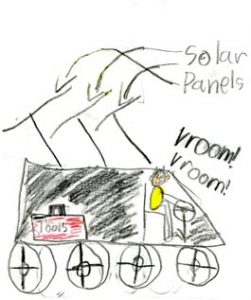
Marcelo E. Blander, age 8, will be an “inventor of solar-powered tech, including video games, computers, TVs, etc.” He’ll get to and from work in a solar-powered car (black, so it attracts more sunlight) and he predicts that “this job will be different than it is now because the solar cells will be smaller.” Marcelo’s tools? Wrenches, hammers and screwdrivers.
Asha Mangione Ethington, 9, will stick closer to home. But like any digital multitasker worthy of the name, she’s upping the ante: “The kinds of jobs I’m gonna have are police officer, actress, firefighter and a singer.”
Naoto and Asha may be joined in their crime-fighting efforts by Jasper Lynn, 9, who also will be the president. “I will change the ways of the president by catching criminals,” he says. “I will work at the White House and get there on a flying motorcycle on my secret freeway called: ‘El President Freeway!’ ” Jasper assures us that the future holds other, just as welcome, surprises: “There will be a lot of girl presidents, unlike me.”
So there you have it. The scholars fret about the effects of digital technology on our working lives. The kids are just eager to start living them. They want to be teachers, writers, firefighters and the president, like American kids have always dreamed of becoming. They’ll just do it with robots, rocket-powered sneakers and flying motorcycles.
And when you get right down to it, whatever the workplace of the future looks like, it still comes down to one thing: making money. Well, maybe not.
Kaitlyn Lee, 5, doesn’t even think people in the 2030s will have to work. That’s because, she says, “We will print our own money.”
To buy robots, no doubt.

